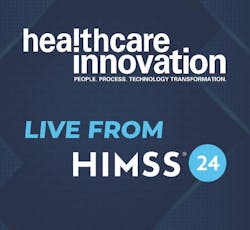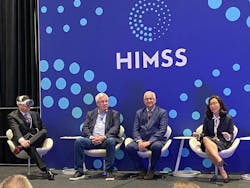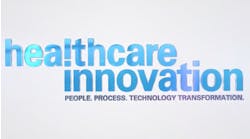Where are patient care organizations—really—on the journey around leveraging artificial intelligence (AI) to improve patient outcomes, support clinicians in their day-to-day workflows, and curb costs? Well, on a day-to-day level, the leaders of patient care organizations nationwide are very busy these days getting down “into the weeds” to apply traditional AI and generative AI solutions wherever it makes sense.
All that was top of mind on the first panel in the AI and Healthcare Preconference Forum at HIMSS24, the annual conference sponsored by the Chicago-based Healthcare Information & Management Systems Society, being held this year at the Orange County Convention Center in Orlando. The first panel of the day in the AI preconference forum was entitled “The Healthcare AI Evolution: A Roadmap for Success.” Harvey Castro, M.D., CEO at Medical Intelligence Ops, was moderator, and was joined by Anna Schoenbaum, D.N.P., M.S., R.N., vice president, applications and digital health at Penn Medicine; Richard Cramer, chief strategist, healthcare and life sciences at Informatica; and Sunil Dadlani, chief information and digital officer and chief information security officer, at Atlantic Health System.
What should we understand about AI? Castro asked. “Traditional AI is more deterministic, and is focused on specific tasks and predictive analytics based on the data you have,” Dadlani said. “I would say that traditional AI has become more mature and has become adopted across clinical and non-clinical areas. Generative AI is more probabilistic, not deterministic; it’s self-learning; it’s more about general issues. It comes with its own ethical and explainability risks. The explainability of generative AI is risky. The two models will compete with each other.”
“At Penn, we’ve been working on generative AI,” Schoenbaum reported. “We do have processes in place, but we’re trying to put policies, support models, and governance in place, to put the guardrails in place, around generative AI development. So we’re doing it, but we’re focusing on how we do it.”
“As an industry, we’ve been doing AI for a long time; the enthusiasm around ChatGPT makes people think it’s new, but it’s not,” Cramer emphasized. “The issue is trustworthiness. We need transparency; I’m a lifelong data analyst. And I like to say that if you’re transparent, I can disagree with your conclusions and still trust you; but if you’re not transparent, I can never trust you. And also, data doesn’t need to be perfect to be useful. But you need to start with accessible, trustworthy, fit-for-purpose data.”
Importantly, Dadlani emphasized, “Over the course of time, performance degrades. And the more data sources we add—the quality of the data will degrade. That’s why it’s important to have a continuous loop. As the data changes, the learning and performance change. And you need to have AI maturing in your organization. Data on one side, and AI maturity on the other hand, go hand in hand.”
Further, “Digital transformation, which has really taken hold across our entire healthcare and life sciences market, is fundamentally a cost reduction enterprise,” Cramer said. “Getting people off the phone to chatbots, being able to automate the doctor’s day at the end of the day—those things reduce cost, improve the patient and member experience, and frequently take the burden off the clinical staff.”
“We can have an impact on clinical and non-clinical areas,” Dadlani noted. “Traditional AI is being used to predict the emergence of diabetes, heart disease, etc., in patients, and can lead to early interventions or preventive care.”
“We’re trying to improve patient outcomes, improve the patient and caregiver experience, and enhance academic research,” Schoenbaum reported. “Per in-baskets, we have 6 million in-basket messages coming into providers every year, and that’s mindblowing. But we’ve also been enhancing the patient portal. We’re working with our vendors to improve in-basket messaging; but it’s work and requires vendor support. It’s an ongoing, iterative process. The tool is being used 15 percent of the time, but when it’s used, it’s saving providers time. They get 6 million messages, so we’ve got to do something. But it takes time and resources. And on the back end, we’ve been implementing a clinical documentation improvement initiative. Our coders can work faster to document better. Ultimately, if we improve patient outcomes, you’ll reduce costs as well.”
A key element in all of this, Dadlani emphasized, is, “Don’t start with the technology; always, always start with the problem you’re trying to solve.”
“I absolutely agree with that,” Schoenbaum confirmed. “It’s really about understanding the problem and making sure that you understand the resources needed. In terms of AI solutions, first, we try to work with existing vendors. Existing vendors are adding new technologies. And we do reviews of the risks and efficacy of new solutions. How do we protect patient data? How is it being shared? We are also building custom applications ourselves. And even though it might be a good approach, it can be hard to keep up with. Fundamentally, it’s the same process, in terms of ensuring security and doing ongoing technology review. But with predictive models, it’s not plug-and-play. You need to engage in continuing reviews, make sure a technology is reliable. That requires being very thoughtful about the solutions you’re adding on.
What’s more, “The performance will degrade over time, because the data will be changing,” Dadlani said, referencing generative AI solutions. “You will need to retrain your models based on the new data.” And this will always be an ongoing process, Dadlani said. “And the risk has to be delegated upstream.”
“We need a governance group that can help to fast-track things,” Schoenbaum emphasized. We have a lot of governance groups, but people need to know which one to go to. And understand what the cost will be if you roll out a solution to every provider. It might be one you ought to invest in. But you need people to govern a technology, develop in, and to sustain it.” Further, she said, “We need to constantly be learning from each other. We have a regional CMIO whom everyone can reach out to. You always have to network and share. We need to share our knowledge with each other.”
In concluding, Cramer said, “You need to make sure you’re understanding the problem you’re solving and the value of working to solve it.” Dadlani said, “I’ll quote Steve Jobs: stay hungry, stay foolish: meaning, stay in a state of constant learning.”



